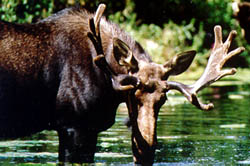Moose
Updated: August 12, 2020

If the plural of mouse is mice, shouldn't the plural of moose be meese? Actually no, the plural of moose is actually "moose." Their scientific name is Alces alces. The moose in Montana are the smallest of four recognized subspecies in North America, called the Wyoming or Shiras moose, after an early explorer to the area around Yellowstone. The others are the Labrador in New England and northeastern Canada, the Canada, and the Alaskan-Yukon moose.
One thing you can bet if it's mossy, it's moose-y. Moose spend most of their time in meadows and marshy areas. A moose's diet is made up mainly of underwater vegetation; when feeding, they often dunk their heads underwater, and can keep their heads submerged for more than three minutes. Moose also browse on a variety of shrubs and saplings.

If you see a moose, you won't soon forget it: moose are the largest antlered animals in the world. The largest antlers can span 6 feet from tip to tip. Even more impressive, moose grow their antlers each spring after they shed their old antlers in the winter. Only the males have antlers, which are huge, flat and dish-shaped. Bulls also have a mane of hair on the back of their neck as well as a pouch of skin called a "bell" hanging down under their chin. .The moose’s hind legs are shorter than their front legs, giving them a sloping back. Adult moose bulls may weigh from 1,200 to 1,400 pounds, and the cows weighing about one-fourth less.

Cows start to have calves at about 2 years old. The female mates between late September and early November and gives birth approximately eight months later. Typically a young cow will have a single calf, which may weigh up to 30 pounds at birth. She will keep the calf near her for about a year or until a new calf is ready to be born. After a cow reaches 4 years old it is common for her to have twins.
Calves are born in early summer. Their coloring is reddish brown but unlike fawns baby moose have no spots. Because the mother’s milk is high in fat and nutrients the calf grows fast and can browse like its mother by the time it is only 3 weeks of age. By fall they will weigh about 300 to 400 pounds.
Moose are unpredictable and can be dangerous. Females with calves and rutting bulls have been known to charge people and cars. A moose in its prime has little to fear from most predators, for few animals apart from man possess the ability to kill it. Timber wolves tend to take either calves separated from their mothers, sick or disabled calves. There are recorded accounts of adult moose standing their ground and successfully fending off entire packs of wolves. The front feet of a moose, as well as its hind ones, are lethal weapons that will take their toll on unwary opponents. A mature bull can run 35 miles per hour as well as swim for miles at a speed faster than two grown men can paddle a canoe.
Thanks for visiting the Montana Kids' Site! We hope you've found the information both educational and entertaining. If you have comments or suggestions on ways we can improve the site please send us email at montanakids@visitmt.com.
You can also help your family plan a trip to Montana. Have your folks request a statewide travel packet by clicking here.

